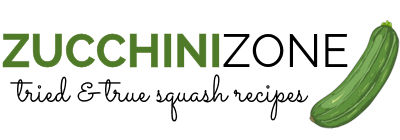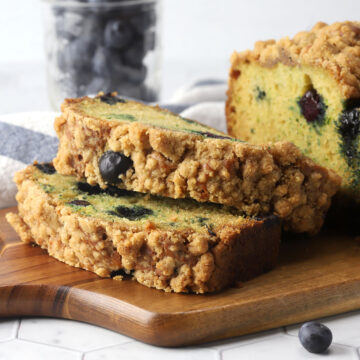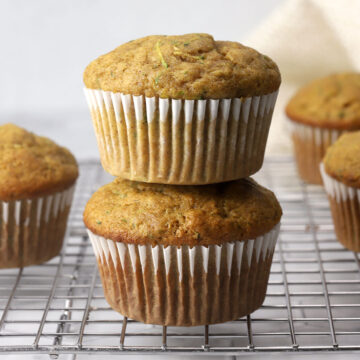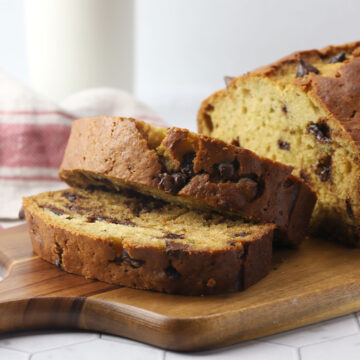Savory zucchini bread is a tender quick bread that's packed with flavors like garlic, parmesan, and chives. It makes a great addition to a bowl of tomato soup or can be enjoyed on its own with a bit of softened butter spread on top.

Looking for more ways to use up that garden zucchini? Savory zucchini bread makes a great alternative to your standard garlic bread. It turns out incredibly soft and tastes great on its own or spread with butter.
Zucchini bread makes an excellent summer baking recipe - all you need are a few bowls, a spoon, and a loaf pan to get started. Plus, it's made with simple baking ingredients you may already have on hand.
One loaf makes ten hearty slices, so it can easily feed a crowd at your next meal. Pair savory zucchini bread with dishes like creamy chicken vegetable soup, tomato soup, or a hearty side salad for a complete meal.
Ingredients and substitutions

- Zucchini - You'll need 220 grams or 1.5 cups of finely grated zucchini (or about 1 to 1.5 medium zucchini). After measuring, you'll need to squeeze the excess liquid from the zucchini so that we don't add too much moisture to the recipe. Too much moisture = soggy and dense bread.
- All-purpose flour - I've only tested this recipe with all-purpose (plain) flour, so I can't say for sure how other flours will turn out. If you have a different type of flour on hand, I recommend searching for a recipe that is developed with that specific flour in mind.
- Buttermilk - This recipe is written to work perfectly with buttermilk and the listed leavening, so regular milk (or other non-dairy milks) won't work as substitutes. If you don't have buttermilk on hand, add 1 tablespoon of white vinegar to a measuring cup, then fill to the 1-cup line with whole milk. Allow it to set for 5 minutes and you'll have a buttermilk substitute that works in this recipe.
- Eggs - Add structure and moisture to the zucchini bread.
- Unsalted butter - Unsalted butter and ⅛ teaspoon of the listed salt can be substituted with salted butter if desired.
- Chives - Add flavor to your bread. Can be omitted if desired.
- Leavening - You'll need both baking powder and baking soda for the proper lift in this recipe.
- Salt - Enhances the flavor of the bread. I do not recommend omitting the salt - your bread will taste bland in comparison.
- Garlic powder - Adds garlicky flavor to your bread. Can be omitted if desired.
- Parmesan cheese - Adds savory flavor to the bread. If desired, it can be substituted with other cheeses like cheddar or gruyere. I recommend using cheese freshly shredded from a block rather than pre-shredded cheeses in a canister or bag. Pre-shredded cheeses are often coated in anti-clumping powders that can add a grainy texture when melted.
Tips and tricks

Shredding zucchini for bread - I recommend using the small side of a box grater to grate zucchini for baked goods. Finely grated zucchini melts seamlessly into the batter when baked with the only sign of zucchini being the tiny green flecks. The large side of a box grater also works but adds a noticeable texture to your baked bread. Here's the box grater I use: OXO Good Grips Box Grater
Gently mix batter - If the batter is overmixed, the gluten is overworked and your bread can turn out tough. Instead, use a gentle stirring motion with a spoon (no need for a stand mixer or hand mixer) and only stir until ingredients are just incorporated.
Pan size - This recipe makes one 9x5 loaf of zucchini bread. These are the pans I use for all my zucchini bread recipes: Farberware Loaf Pan 9x5, Set of 2
Storage
Zucchini bread can be stored at room temperature for 3 to 4 days in a tightly sealed container.
Zucchini bread can be frozen for up to 6 months in a tightly sealed, freezer-safe container. To thaw a whole loaf, place on the countertop for up to 3 hours to bring to room temperature. Single slices will thaw in about 1 hour or less.
See my full post for more information: How To Store Zucchini Bread
Frequently asked questions

No, there's no need to peel your zucchini before shredding it for zucchini bread. The skin of the zucchini contains fiber and other nutrients you'd otherwise be missing out on by peeling it off.
Once your bread is baked, the only sign of zucchini is tiny flecks of green throughout. Otherwise, the zucchini (skin included) melts right into the bread.
Yes, for this recipe you'll need to squeeze the excess liquid from the shredded zucchini before adding it to the batter. Too much liquid will make this bread soggy, gummy, and dense.
No, zucchini has a mild flavor that makes it ideal for baking. Cucumber has a fresh "melon" flavor that's much more pronounced and not ideal for hiding in baked goods. For more information: Zucchini vs Cucumber - What's the Difference?
If you're using a large zucchini with mature, hard seeds inside, use a spoon to scoop out the seeds before grating.
I recommend shredding zucchini using the small or "fine" side of a box grater. The smaller pieces melt right into the zucchini bread as it bakes. A larger grate also works but adds a more noticeable texture. Here's the box grater I use: Amazon: OXO Good Grips Box Grater
Troubleshooting
If your baked zucchini bread turned out soggy or sinking in the center, then it was either underbaked or had too much moisture. Make sure not to add extra wet ingredients to this recipe, like extra zucchini, a dollop of sour cream, applesauce, or extra vegetable oil. This recipe includes exact measurements of wet and dry ingredients to ensure your bread turns out perfectly baked and moist, not wet or soggy.
Dry baked goods can happen for several reasons. Either your bread was overbaked, too many dry ingredients (like flour) were added to the recipe, or the moisture-adding ingredients (eggs, butter, buttermilk, zucchini) were reduced.
Bland baked goods can happen for a few reasons. Omitting the salt, reducing the sugar, or adding too much flour can cause your bread to turn out bland. Salt enhances the flavors of the other ingredients - it's not there to make your bread "salty". Measure flour accurately by weighing it using the gram measurements listed in the recipe card. If you don't have a scale, use the spoon and level method. Gently spoon flour into a measuring cup, then level off the top with a knife. Scooping flour with a measuring cup compacts flour into the cup, adding up to 25% extra flour to the recipe. Decreasing the listed sugar can also make your bread turn out bland (and sometimes dry).
📖 Recipe
Savory Zucchini Bread
Ingredients
- 1.5 cups (220 g) finely grated zucchini, after measuring, squeeze liquid out
- 1 cup (227 g) buttermilk
- 2 large eggs
- ¼ cup (56 g) unsalted butter, melted
- 2 ¼ cups (270 g) all-purpose flour
- 2 teaspoons baking powder
- ½ teaspoon baking soda
- 1 teaspoon garlic powder
- ½ teaspoon salt
- ½ cup (56 g) freshly grated parmesan cheese
- 2 tablespoons chopped chives
Instructions
- Preheat oven to 350 degrees Fahrenheit. Lightly grease one 9x5 loaf pan (or line with parchment paper) and set aside.
- In a bowl, add finely grated zucchini (after liquid has been squeezed out), buttermilk, eggs, and melted butter. Whisk until evenly incorporated. Set aside.
- In a large bowl, whisk together dry ingredients: flour, baking soda, baking powder, garlic powder, and salt. Make a well in the center of the dry ingredients and add wet ingredients. Stir until incorporated. Add cheese and chives and stir just until incorporated. Batter will be thick.
- Pour into prepared loaf pan. Bake for about 48 to 55 minutes, OR until a toothpick inserted into the center comes out clean/with dry crumbs, or bread reaches 200 to 205 degrees Fahrenheit in the center (baking times will vary based on your oven and type of pan used).
- Allow bread to cool completely on the counter before removing from pan and slicing.
Recommended Equipment
Notes
- Leftover zucchini bread will keep in a tightly sealed container at room temperature for up to 3 days, or in the refrigerator for up to 7 days. If your bread is very moist/wet, I recommend refrigerating.
- Zucchini bread can be frozen for up to 6 months. Tightly wrap in plastic wrap/foil and store in a freezer safe bag or container. Thaw on the counter top for 1 to 3 hours.










Comments
No Comments